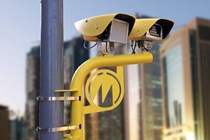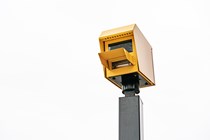The UK’s roads are littered with speed cameras and our advice is to always stick to the speed limit to avoid getting a fine and points on your driving licence. There are more than 7,000 units dotted around our highways – with many more added in the last few years as part of the government’s smart motorway programme.
Currently, Britain has the fourth highest number of speed cameras in the world, trailing only Brazil, Italy and Russia. As such, we can almost guarantee that either you or someone you know has been caught by a speed camera at some point in the 30-plus years since there were first introduced.
In this article, we’re going to cover the most common types of speed camera currently used on UK roads, with clear pictures of each unit, so you know what to watch out for. We’ll also explain how each camera system works.
If you’re concerned about getting snapped by a speed camera, you could invest in a radar detector. Bear in mind, though, that this technology will only work for camera systems that use radar emitters to track the speed of your car. If you’ve got a more modern car with intelligent speed assistance, you can programme the technology to automatically prevent you from exceeding the speed limit.
UK speed cameras
Gatso speed cameras
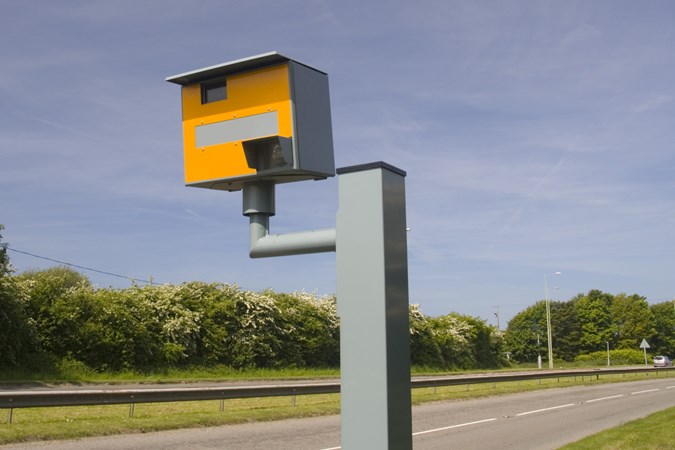
These are the most common speed cameras found on UK roads. Gatso introduced the UK’s first ever speed camera in 1991, which used physical film rolls to record speeding motorists. Now, they snap digital photos – but their size and shape hasn’t changed much over the years.
Gatso cameras are big, bright yellow boxes mounted on poles at the roadside which use radar sensors to monitor the speed of approaching traffic. They face rearwards, taking a picture of the back of a car if it drives past over the speed limit. Trigger a Gatso camera and you’ll see a flash in your rear-view mirror.
In front of the camera, you’ll see a series of white lines painted on the road. These are used to check the driver’s speed. The camera takes two photos in quick succession, and the distance the car has covered between the two images is used to work out the speed.
Jenoptik Vector-SR cameras

Jenoptik Vector-SR cameras come from the same company that makes the SPECS cameras covered below. They can monitor a car’s average speeds and they’re also used to enforce a host of other driving regulations such as congestion charging zones, yellow box violations, bus lane usage and catching red light runners.
The average speed-enforcing Vector cameras are mounted on massive yellow poles at the roadside. There’s often just one camera perched atop each stick, as a single unit can be used to monitor two lanes of traffic. The system is even clever enough to keep tabs on a two-way road and even dual carriageways.
Cameras that aren’t enforcing speeding offences are normally painted grey, which makes them a lot harder to spot – especially when they’re buried alongside street furniture. Every version of the camera uses an ANPR system that can identify cars the police are interested in from their number plate.
Truvelo Combi speed cameras
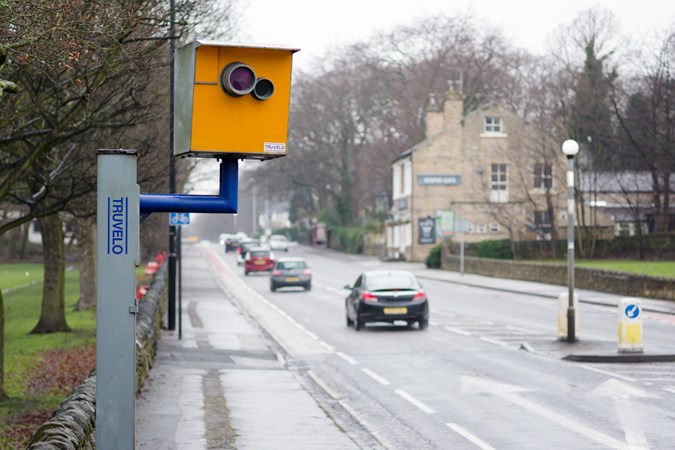
Truvelo cameras work a little differently to Gatsos. For starters, they’re front-facing units, which means they can be used to identify the driver of a speeding vehicle. They also don’t flash like a Gatso – they feature an infrared flash to avoid dazzling the driver.
Ahead of the camera, there’s a series of piezo sensors embedded in the road surface. They measure the vehicle’s speed as it drives along the road and, if it’s travelling faster than it should be, a signal is sent to the camera unit to snap the picture.
They’re a similar size and shape to the Gatso camera and they’re also paired with white lines on the road which are used as a secondary check for the car’s speed. Some units also have an external flash unit mounted on a separate pole next to the camera.
Truvelo D-Cam speed cameras
This is the next-generation, digital version of the Truvelo Combi. It was launched in 2013 and can be mounted in either front- or rear-facing configurations. It can also be used to monitor motoring offences other than speeding, such as red light running.
Most work in the same way as the Truvelo Combi, using sensors in the road to monitor the speed of approaching traffic. If a car is travelling over the speed limit, the sensors trigger the camera. The D-Cam also uses an infrared flash to avoid dazzling the driver.
However, there is a variant of the Truvelo D-Cam which uses a laser to measure the speed of passing vehicles. It works on the same principles as a police officer’s handheld speed gun – if a car registers too high a speed, the camera records the offending vehicle.
SpeedCurb speed cameras

SpeedCurb cameras are a blend between Gatso and Truvelo units. They take pictures of the rear of a vehicle like the former system, but they use sensors embedded in the road surface to register the speed of passing traffic like the latter.
If you drive past a SpeedCurb camera too quickly, the camera will take three pictures of your car. The first two are wide-angle shots which show the vehicle and the area it’s driving through, while the final one is a close-up image of the licence plate.
Like a Gatso camera, the first two images are used as a secondary check on the vehicle’s speed. There are white lines painted on the ground ahead of the camera, and the distance the car has covered between the two images is used to work out its speed.
Peek speed cameras
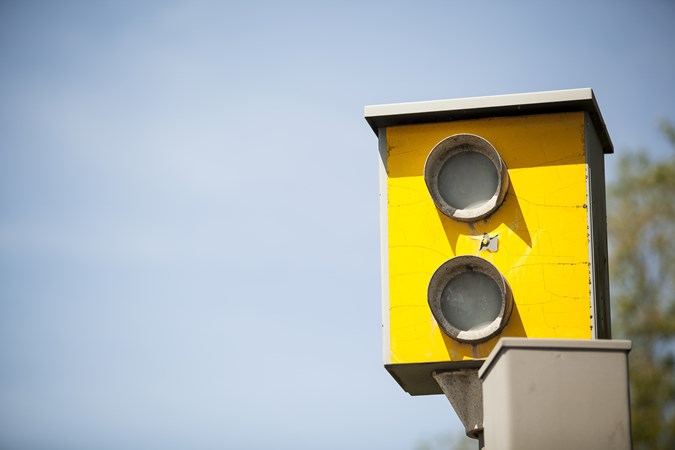
These slightly gawky-looking cameras work in the same way as Gatso units. They use radar technology to monitor the speed of passing traffic. If you’re travelling faster than the speed limit, it’ll snap a picture of the rear of your vehicle. They’re not all that common in the UK.
HADECS 3 speed cameras
Ever driven on a Smart Motorway? You’ll have passed plenty of these. The acronym stands for Highways Agency Digital Enforcement Camera System – and the units are some of the newest and cleverest speed camera systems to be installed on UK roads.
When they were launched, they quickly gained the nickname ‘stealth camera’. They’re small and mounted either on the side or rear of motorway gantries, which makes them very hard to spot when whizzing past at (ahem – roughly) 70mph. Some are even painted a sneaky shade of grey, rather than the fluorescent yellow of the other camera systems outlined here.
The system’s technology is verging on weapons-grade levels of sophistication. HADECS 3 cameras can monitor up to five lanes of traffic at once, using two radar systems built into each unit. If a car passes under one travelling in excess of the speed limit, the camera snaps the car’s plate and automatically sends the case to a central computer to be processed.
As they monitor Smart Motorways, the speed these cameras enforce is also completely variable. Just because the national speed limit on motorways is 70mph doesn’t mean you’re always immune from prosecution if you stick to that speed. If the overhead gantries display a 50mph limit, for example, these cameras will record you as an offender.
They can also ‘see’ up to two kilometres along the carriageway. So, if you can still see the gantry a HADECS 3 camera is mounted to, the camera can still see you.
SPECS speed cameras
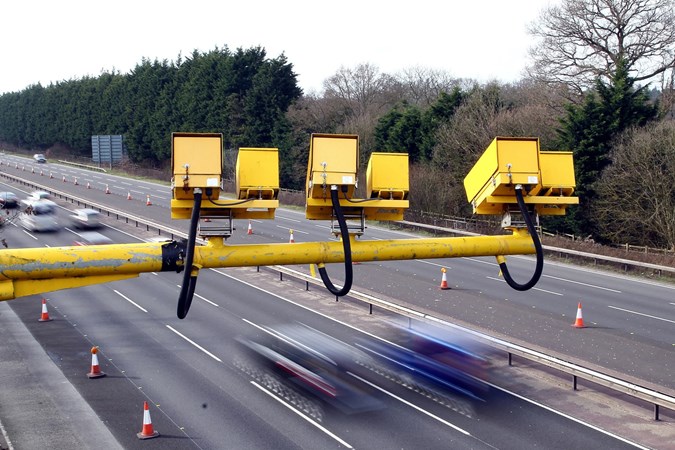
How do average speed cameras like the SPECS system work? Well, instead of checking your speed at a fixed location, they monitor it over a distance. They can keep tabs on you for several miles and will issue a ticket if your speed is greater than the set limit over the section of road they’re fixed to.
They’re normally mounted on dual carriageways and motorways, and there will always be at least two cameras per stretch of enforced highway – one to clock you in and one to clock you out. When you pass under the first one, an Automatic Number Plate Recognition (ANPR) camera registers a timestamp to your car and starts a stopwatch.
Say the cameras are enforcing a two-mile stretch of road with a 60mph speed limit. If you’re travelling at the speed limit, it should take you two minutes to cover that distance – and that’s the yardstick the cameras’ timers use to judge you (with a little bit of leeway in most cases). If you reach the second camera faster than that, the system will issue you with a ticket.
Mobile speed camera vans
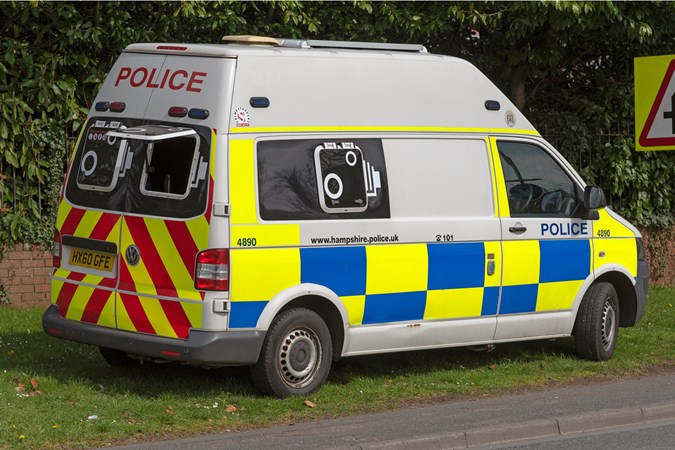
As the name suggests, mobile speed cameras are mounted in the back of police vans which are parked on the side of the road at accident hot spots. Commonly, they measure your speed using either a laser or a radar emitter, which bounces off the surface of your car and back to the receiver.
The laser models have a range of about a mile, while the radar variants can only track you for a couple hundred feet. Since there’s no way of telling which device the officer has from the outside of the van, your best bet is to stick to the speed limit. Navigation applications such as Waze can warn you of police camera vans along your route.
Other traffic enforcement cameras
Speed cameras in all their variety are just one form of traffic enforcement camera in use on the UK’s roads. Other cameras are used to detect other violations of traffic laws such as running through a red light, sitting in a yellow box junction, not wearing a seatbelt and so on. So-called noise cameras are also being trialled to detect cars with illegally loud exhausts, as are cameras that can spot if a driver is using their phone.
Some cameras are specific to each enforcement task, others are multi-purpose and can spot a range of different offences. While the cameras are triggered automatically, the images are usually checked manually to make sure that an offence occurred.
Then there are the CCTV cameras covering the UK’s road network. They are constantly monitored and operatives can immediately send footage of any offences they see being committed to the police.
FAQs
-
What happens if you get caught by a speed camera?
If you get caught speeding by a speed camera, the offence is automatically registered on the relevant police authority’s computer system. The photos and data are usually checked manually by a dedicated officer and a decision is made about whether to issue a Notice of Intended Prosecution which is posted to you.
Depending on the seriousness of the offence, you can be offered the opportunity to attend a speed awareness course (which you have to pay for) or be issued with a fine and driving license penalty points. In either case, you can appeal if you wish. -
How long does it take for a speed ticket to come through?
If you get caught speeding, you should receive a Notice of Intended Prosecution by post within 14 days. You then have 28 days to either book a speed awareness course or pay the fine, depending on the options you’re offered.
-
Can you check if you’ve been caught speeding?
Unfortunately, there is no way of checking if you’ve been caught speeding. If you have indeed been caught speeding, you will receive a Notice of Intended Prosecution (NIP) letter from the local police within 14 days of the offence.
-
What speed will trigger a speed camera?
UK speed cameras have a tolerance of up to 10% of the speed limit plus two miles per hour, to account for faulty or erroneous speedometers. So, if you’re driving in a 50mph zone at 57mph, you may not get flashed by a camera, but we always recommend keeping to the speed limit to stay on the right side of the law. Though most cameras offer such leniency, it differs between police forces and you may not always be so lucky.
-
Can you slow down before a speed camera?
You shouldn’t need to, of course, because you’re sticking to the speed limit. Having said that, whether or not this tactic works depends on the type of speed camera in use. If there are distance markers on the road, the camera can probably only see them, so won’t catch you slowing down before, then speeding up after.
However, most speed cameras currently in use don’t actually need distance markers and can detect speeding anywhere within their field of view, which can be up to two kilometres long. So it’s best to work on the basis that, if you can see the camera, it can see you.
Braking and speeding up either side of average speed cameras is completely futile. The cameras are positioned at relatively short intervals, and you’ll probably still get through the zone too quickly, anyway. -
How do average speed cameras work?
The time it takes to travel a given distance at a certain speed is easily calculated. For instance, it takes precisely 12 minutes to cover 10 miles at 50mph. And that’s the basis average speed cameras work on. The camera at the start of an average speed zone clocks each vehicle in, the one at the end clocks them out. If a vehicle goes through the zone too quickly, a penalty notice may be issued.
Just so you know, we may receive a commission or other compensation from the links on this website - read why you should trust us.




